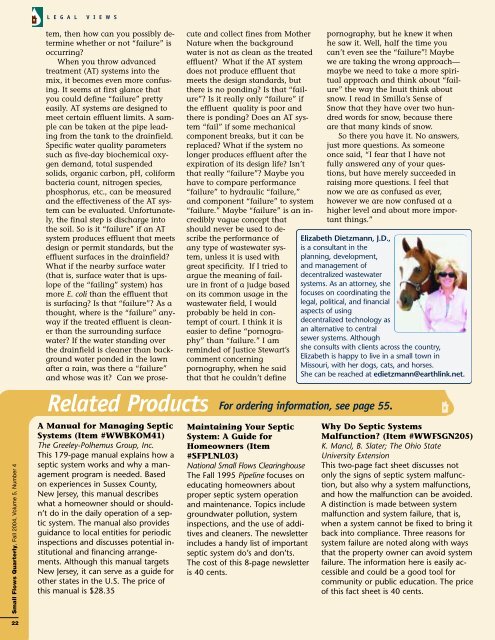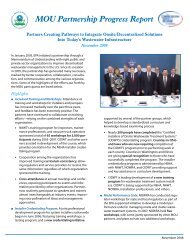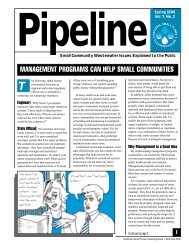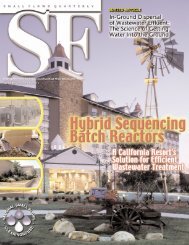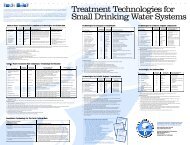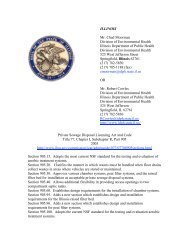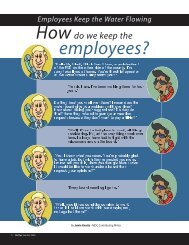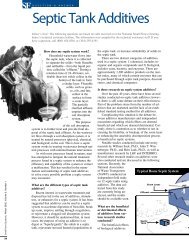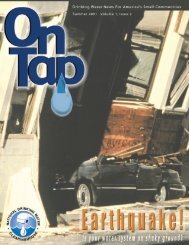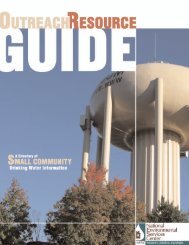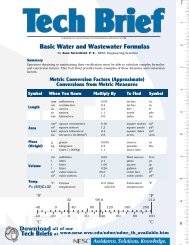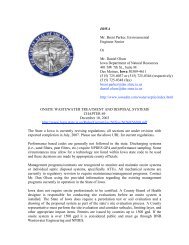Download - National Environmental Services Center - West Virginia ...
Download - National Environmental Services Center - West Virginia ...
Download - National Environmental Services Center - West Virginia ...
Create successful ePaper yourself
Turn your PDF publications into a flip-book with our unique Google optimized e-Paper software.
L E G A L V I E W S<br />
cute and collect fines from Mother<br />
Nature when the background<br />
water is not as clean as the treated<br />
effluent? What if the AT system<br />
does not produce effluent that<br />
meets the design standards, but<br />
there is no ponding? Is that “failure”?<br />
Is it really only “failure” if<br />
the effluent quality is poor and<br />
there is ponding? Does an AT system<br />
“fail” if some mechanical<br />
component breaks, but it can be<br />
replaced? What if the system no<br />
longer produces effluent after the<br />
expiration of its design life? Isn’t<br />
that really “failure”? Maybe you<br />
have to compare performance<br />
“failure” to hydraulic “failure,”<br />
and component “failure” to system<br />
“failure.” Maybe “failure” is an incredibly<br />
vague concept that<br />
should never be used to describe<br />
the performance of<br />
any type of wastewater system,<br />
unless it is used with<br />
great specificity. If I tried to<br />
argue the meaning of failure<br />
in front of a judge based<br />
on its common usage in the<br />
wastewater field, I would<br />
probably be held in contempt<br />
of court. I think it is<br />
easier to define “pornography”<br />
than “failure.” I am<br />
reminded of Justice Stewart’s<br />
comment concerning<br />
pornography, when he said<br />
that that he couldn’t define<br />
tem, then how can you possibly determine<br />
whether or not “failure” is<br />
occurring?<br />
When you throw advanced<br />
treatment (AT) systems into the<br />
mix, it becomes even more confusing.<br />
It seems at first glance that<br />
you could define “failure” pretty<br />
easily. AT systems are designed to<br />
meet certain effluent limits. A sample<br />
can be taken at the pipe leading<br />
from the tank to the drainfield.<br />
Specific water quality parameters<br />
such as five-day biochemical oxygen<br />
demand, total suspended<br />
solids, organic carbon, pH, coliform<br />
bacteria count, nitrogen species,<br />
phosphorus, etc., can be measured<br />
and the effectiveness of the AT system<br />
can be evaluated. Unfortunately,<br />
the final step is discharge into<br />
the soil. So is it “failure” if an AT<br />
system produces effluent that meets<br />
design or permit standards, but the<br />
effluent surfaces in the drainfield?<br />
What if the nearby surface water<br />
(that is, surface water that is upslope<br />
of the “failing” system) has<br />
more E. coli than the effluent that<br />
is surfacing? Is that “failure”? As a<br />
thought, where is the “failure” anyway<br />
if the treated effluent is cleaner<br />
than the surrounding surface<br />
water? If the water standing over<br />
the drainfield is cleaner than background<br />
water ponded in the lawn<br />
after a rain, was there a “failure”<br />
and whose was it? Can we prosepornography,<br />
but he knew it when<br />
he saw it. Well, half the time you<br />
can’t even see the “failure”! Maybe<br />
we are taking the wrong approach—<br />
maybe we need to take a more spiritual<br />
approach and think about “failure”<br />
the way the Inuit think about<br />
snow. I read in Smilla’s Sense of<br />
Snow that they have over two hundred<br />
words for snow, because there<br />
are that many kinds of snow.<br />
So there you have it. No answers,<br />
just more questions. As someone<br />
once said, “I fear that I have not<br />
fully answered any of your questions,<br />
but have merely succeeded in<br />
raising more questions. I feel that<br />
now we are as confused as ever,<br />
however we are now confused at a<br />
higher level and about more important<br />
things.”<br />
Elizabeth Dietzmann, J.D.,<br />
is a consultant in the<br />
planning, development,<br />
and management of<br />
decentralized wastewater<br />
systems. As an attorney, she<br />
focuses on coordinating the<br />
legal, political, and financial<br />
aspects of using<br />
decentralized technology as<br />
an alternative to central<br />
sewer systems. Although<br />
she consults with clients across the country,<br />
Elizabeth is happy to live in a small town in<br />
Missouri, with her dogs, cats, and horses.<br />
She can be reached at edietzmann@earthlink.net.<br />
Small Flows Quarterly, Fall 2004, Volume 5, Number 4<br />
Related Products For ordering information, see page 55.<br />
A Manual for Managing Septic<br />
Systems (Item #WWBKOM41)<br />
The Greeley-Polhemus Group, Inc.<br />
This 179-page manual explains how a<br />
septic system works and why a management<br />
program is needed. Based<br />
on experiences in Sussex County,<br />
New Jersey, this manual describes<br />
what a homeowner should or shouldn’t<br />
do in the daily operation of a septic<br />
system. The manual also provides<br />
guidance to local entities for periodic<br />
inspections and discusses potential institutional<br />
and financing arrangements.<br />
Although this manual targets<br />
New Jersey, it can serve as a guide for<br />
other states in the U.S. The price of<br />
this manual is $28.35<br />
Maintaining Your Septic<br />
System: A Guide for<br />
Homeowners (Item<br />
#SFPLNL03)<br />
<strong>National</strong> Small Flows Clearinghouse<br />
The Fall 1995 Pipeline focuses on<br />
educating homeowners about<br />
proper septic system operation<br />
and maintenance. Topics include<br />
groundwater pollution, system<br />
inspections, and the use of additives<br />
and cleaners. The newsletter<br />
includes a handy list of important<br />
septic system do’s and don’ts.<br />
The cost of this 8-page newsletter<br />
is 40 cents.<br />
Why Do Septic Systems<br />
Malfunction? (Item #WWFSGN205)<br />
K. Mancl, B. Slater; The Ohio State<br />
University Extension<br />
This two-page fact sheet discusses not<br />
only the signs of septic system malfunction,<br />
but also why a system malfunctions,<br />
and how the malfunction can be avoided.<br />
A distinction is made between system<br />
malfunction and system failure, that is,<br />
when a system cannot be fixed to bring it<br />
back into compliance. Three reasons for<br />
system failure are noted along with ways<br />
that the property owner can avoid system<br />
failure. The information here is easily accessible<br />
and could be a good tool for<br />
community or public education. The price<br />
of this fact sheet is 40 cents.<br />
22


